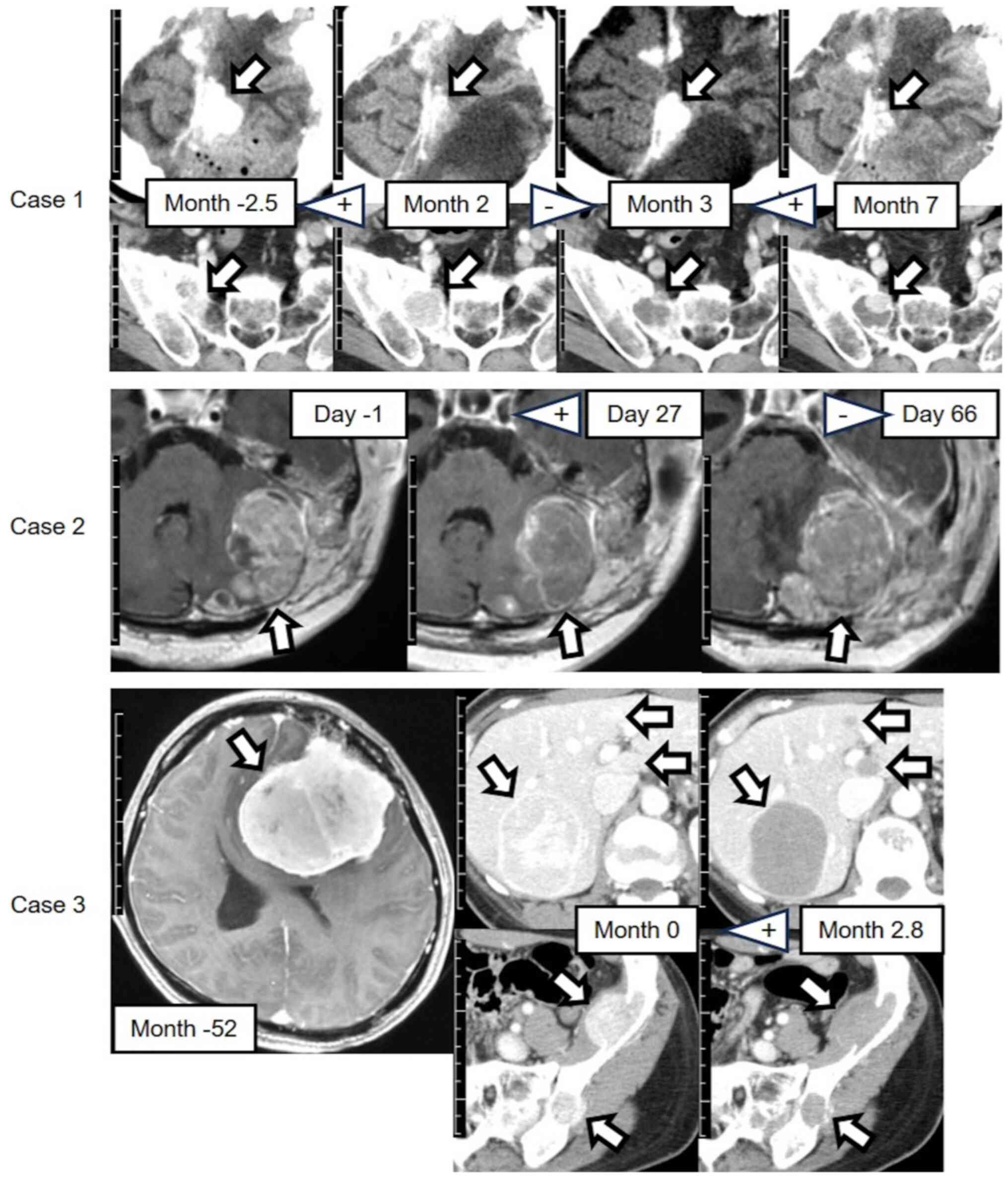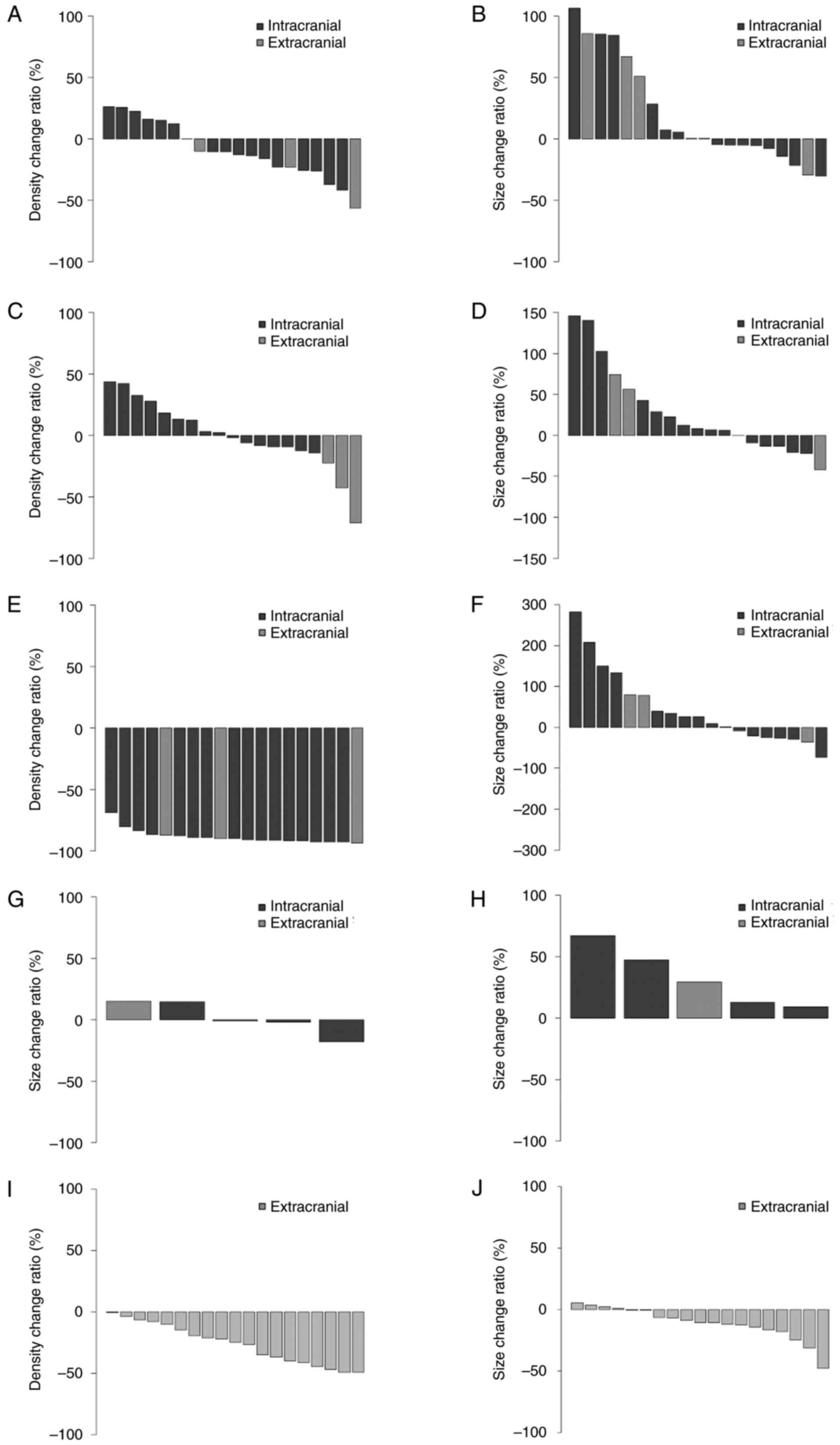|
1
|
WHO Classification of Tumours Editorial
Board, . Mesenchymal, non-meningothelial tumours involving the CNS.
Central Nervous System Tumours. WHO Classification of Tumours (5th
edition). International Agency for Research on Cancer; Lyon: pp.
299–305. 2021
|
|
2
|
Kinslow CJ, Bruce SS, Rae AI, Sheth SA,
McKhann GM, Sisti MB, Bruce JN, Sonabend AM and Wang TJC:
Solitary-fibrous tumor/hemangiopericytoma of the central nervous
system: A population-based study. J Neurooncol. 138:173–182. 2018.
View Article : Google Scholar : PubMed/NCBI
|
|
3
|
Trifiletti DM, Mehta GU, Grover S and
Sheehan JP: Clinical management and survival of patients with
central nervous system hemangiopericytoma in the national cancer
database. J Clin Neurosci. 44:169–174. 2017. View Article : Google Scholar : PubMed/NCBI
|
|
4
|
Rutkowski MJ, Sughrue ME, Kane AJ, Aranda
D, Mills SA, Barani IJ and Parsa AT: Predictors of mortality
following treatment of intracranial hemangiopericytoma. J
Neurosurg. 113:333–339. 2010. View Article : Google Scholar : PubMed/NCBI
|
|
5
|
Ratneswaren T, Hogg FRA, Gallagher MJ and
Ashkan K: Surveillance for metastatic hemangiopericytoma-solitary
fibrous tumors-systematic literature review on incidence,
predictors and diagnosis of extra-cranial disease. J Neurooncol.
138:447–467. 2018. View Article : Google Scholar : PubMed/NCBI
|
|
6
|
de Bernardi A, Dufresne A, Mishellany F,
Blay JY, Ray-Coquard I and Brahmi M: Novel therapeutic options for
solitary fibrous tumor: Antiangiogenic therapy and beyond. Cancers
(Basel). 14:10642022. View Article : Google Scholar : PubMed/NCBI
|
|
7
|
Schweizer L, Koelsche C, Sahm F, Piro RM,
Capper D, Reuss DE, Pusch S, Habel A, Meyer J, Göck T, et al:
Meningeal hemangiopericytoma and solitary fibrous tumors carry the
NAB2-STAT6 fusion and can be diagnosed by nuclear expression of
STAT6 protein. Acta Neuropathol. 125:651–658. 2013. View Article : Google Scholar : PubMed/NCBI
|
|
8
|
Gao F, Ling C, Shi L, Commins D, Zada G,
Mack WJ and Wang K: Inversion-mediated gene fusions involving
NAB2-STAT6 in an unusual malignant meningioma. Br J Cancer.
109:1051–1055. 2013. View Article : Google Scholar : PubMed/NCBI
|
|
9
|
Robinson DR, Wu YM, Kalyana-Sundaram S,
Cao X, Lonigro RJ, Sung YS, Chen CL, Zhang L, Wang R, Su F, et al:
Identification of recurrent NAB2-STAT6 gene fusions in solitary
fibrous tumor by integrative sequencing. Nat Genet. 45:180–185.
2013. View
Article : Google Scholar : PubMed/NCBI
|
|
10
|
Pottier C, Fresnais M, Gilon M, Jérusalem
G, Longuespée R and Sounni NE: Tyrosine Kinase inhibitors in
cancer: Breakthrough and challenges of targeted therapy. Cancers
(Basel). 12:7312020. View Article : Google Scholar : PubMed/NCBI
|
|
11
|
Zhao Y and Adjei AA: Targeting
angiogenesis in cancer therapy: Moving beyond vascular endothelial
growth factor. Oncologist. 20:660–673. 2015. View Article : Google Scholar : PubMed/NCBI
|
|
12
|
Hamberg P, Verweij J and Sleijfer S:
(Pre-)clinical pharmacology and activity of pazopanib, a novel
multikinase angiogenesis inhibitor. Oncologist. 15:539–547. 2010.
View Article : Google Scholar : PubMed/NCBI
|
|
13
|
Kumar R, Knick VB, Rudolph SK, Johnson JH,
Crosby RM, Crouthamel MC, Hopper TM, Miller CG, Harrington LE,
Onori JA, et al: Pharmacokinetic-pharmacodynamic correlation from
mouse to human with pazopanib, a multikinase angiogenesis inhibitor
with potent antitumor and antiangiogenic activity. Mol Cancer Ther.
6:2012–2021. 2007. View Article : Google Scholar : PubMed/NCBI
|
|
14
|
van der Graaf WT, Blay JY, Chawla SP, Kim
DW, Bui-Nguyen B, Casali PG, Schöffski P, Aglietta M, Staddon AP,
Beppu Y, et al: Pazopanib for metastatic soft-tissue sarcoma
(PALETTE): A randomised, double-blind, placebo-controlled phase 3
trial. Lancet. 379:1879–1886. 2012. View Article : Google Scholar : PubMed/NCBI
|
|
15
|
Martin-Broto J, Stacchiotti S, Lopez-Pousa
A, Redondo A, Bernabeu D, de Alava E, Casali PG, Italiano A,
Gutierrez A, Moura DS, et al: Pazopanib for treatment of advanced
malignant and dedifferentiated solitary fibrous tumour: A
multicentre, single-arm, phase 2 trial. Lancet Oncol. 20:134–144.
2019. View Article : Google Scholar : PubMed/NCBI
|
|
16
|
Choi H, Charnsangavej C, Faria SC,
Macapinlac HA, Burgess MA, Patel SR, Chen LL, Podoloff DA and
Benjamin RS: Correlation of computed tomography and positron
emission tomography in patients with metastatic gastrointestinal
stromal tumor treated at a single institution with imatinib
mesylate: Proposal of new computed tomography response criteria. J
Clin Oncol. 25:1753–1759. 2007. View Article : Google Scholar : PubMed/NCBI
|
|
17
|
Apra C, Alentorn A, Mokhtari K,
Kalamarides M and Sanson M: Pazopanib efficacy in recurrent central
nervous system hemangiopericytomas. J Neurooncol. 139:369–372.
2018. View Article : Google Scholar : PubMed/NCBI
|
|
18
|
Lee SJ, Kim ST, Park SH, Choi YL, Park JB,
Kim SJ and Lee J: Successful use of pazopanib for treatment of
refractory metastatic hemangiopericytoma. Clin Sarcoma Res.
4:132014. View Article : Google Scholar : PubMed/NCBI
|
|
19
|
Nakamura T, Matsumine A, Kawai A, Araki N,
Goto T, Yonemoto T, Sugiura H, Nishida Y, Hiraga H, Honoki K, et
al: The clinical outcome of pazopanib treatment in Japanese
patients with relapsed soft tissue sarcoma: A Japanese
musculoskeletal oncology group (JMOG) study. Cancer. 122:1408–1416.
2016. View Article : Google Scholar : PubMed/NCBI
|
|
20
|
Common Terminology Criteria for Adverse
Events (CTCAE), . V5.0, 2017. https://ctep.cancer.gov/protocoldevelopment/electronic_applications/docs/ctcae_v5_quick_reference_5×7.pdf
|
|
21
|
Liu J, Yan S, Du J, Teng L, Yang R, Xu P
and Tao W: Mechanism and treatment of diarrhea associated with
tyrosine kinase inhibitors. Heliyon. 10:e275312024. View Article : Google Scholar : PubMed/NCBI
|
|
22
|
Tullemans BME, Nagy M, Sabrkhany S,
Griffioen AW, Oude Egbrink MGA, Aarts M, Heemskerk JWM and Kuijpers
MJE: Tyrosine kinase inhibitor pazopanib inhibits platelet
procoagulant activity in renal cell carcinoma patients. Front
Cardiovasc Med. 5:1422018. View Article : Google Scholar : PubMed/NCBI
|
|
23
|
Justice CN, Derbala MH, Baich TM, Kempton
AN, Guo AS, Ho TH and Smith SA: The impact of pazopanib on the
cardiovascular system. J Cardiovasc Pharmacol Ther. 23:387–398.
2018. View Article : Google Scholar : PubMed/NCBI
|
|
24
|
Maeda O, Ohka F, Maesawa S, Matsuoka A,
Shimokata T, Mitsuma A, Urakawa H, Nakamura S, Shimoyama Y,
Nakaguro M, et al: Solitary fibrous tumor/hemangiopericytoma
treated with temozolomide plus bevacizumab: A report of four cases
and literature review. Nagoya J Med Sci. 82:631–644.
2020.PubMed/NCBI
|
|
25
|
Eisenhauer EA, Therasse P, Bogaerts J,
Schwartz LH, Sargent D, Ford R, Dancey J, Arbuck S, Gwyther S,
Mooney M, et al: New response evaluation criteria in solid tumours:
Revised RECIST guideline (version 1.1). Eur J Cancer. 45:228–247.
2009. View Article : Google Scholar : PubMed/NCBI
|
|
26
|
Sawayama S, Murakami R, Aki M, Kawaguchi
Y, Takao Y, Nonogaki H, Goto T and Yamauchi C: Efficacy of
pazopanib in FGFR1-amplified uterine carcinosarcoma: A case report.
Gynecol Oncol Rep. 41:1009932022. View Article : Google Scholar : PubMed/NCBI
|
|
27
|
Mondaza-Hernandez JL, Moura DS,
Lopez-Alvarez M, Sanchez-Bustos P, Blanco-Alcaina E,
Castilla-Ramirez C, Collini P, Merino-Garcia J, Zamora J,
Carrillo-Garcia J, et al: ISG15 as a prognostic biomarker in
solitary fibrous tumour. Cell Mol Life Sci. 79:4342022. View Article : Google Scholar : PubMed/NCBI
|
|
28
|
Napolitano A, Moura DS, Hindi N,
Mondaza-Hernandez JL, Merino-Garcia JA, Ramos R, Dagrada GP,
Stacchiotti S, Graziano F, Vincenzi B and Martin-Broto J:
Expression of p53 as a biomarker of pazopanib efficacy in solitary
fibrous tumours: Translational analysis of a phase II trial. Ther
Adv Med Oncol. 14:175883592211161552022. View Article : Google Scholar : PubMed/NCBI
|
|
29
|
Kanda Y: Investigation of the freely
available easy-to-use software ‘EZR’ for medical statistics. Bone
Marrow Transplant. 48:452–458. 2013. View Article : Google Scholar : PubMed/NCBI
|
|
30
|
Giannini C, Rushing EJ, Hainfellner JA,
Bouvier C, Figarella-Branger D, von Deimling A, Wesseling P and
Antonescu CR: Solitary fibrous tumour/haemangioparicytoma. WHO
Classification of Tumours of the Central Nervous System. (Revised
4th edition). International Agency for Research on Cancer; Lyon:
pp. 248–254. 2016
|












